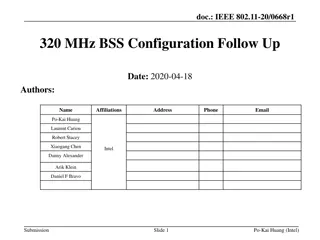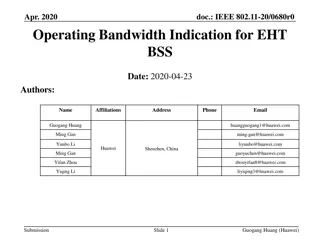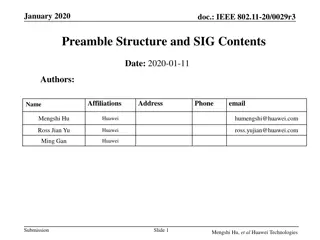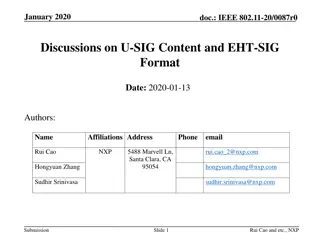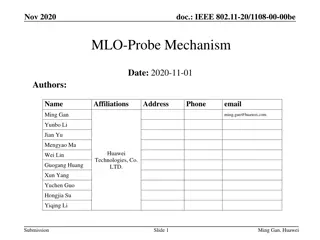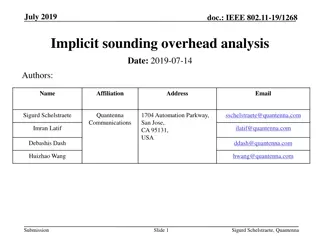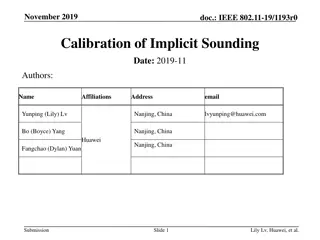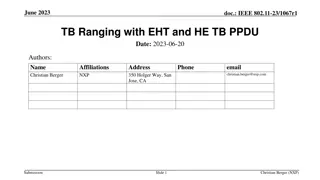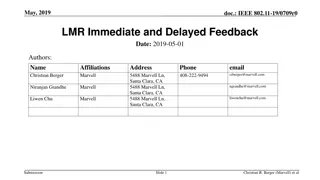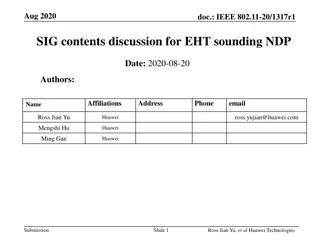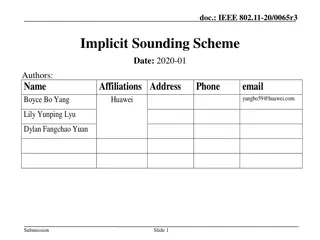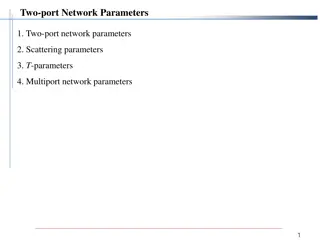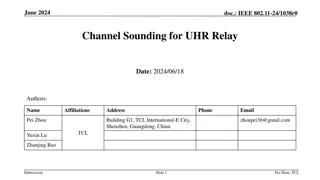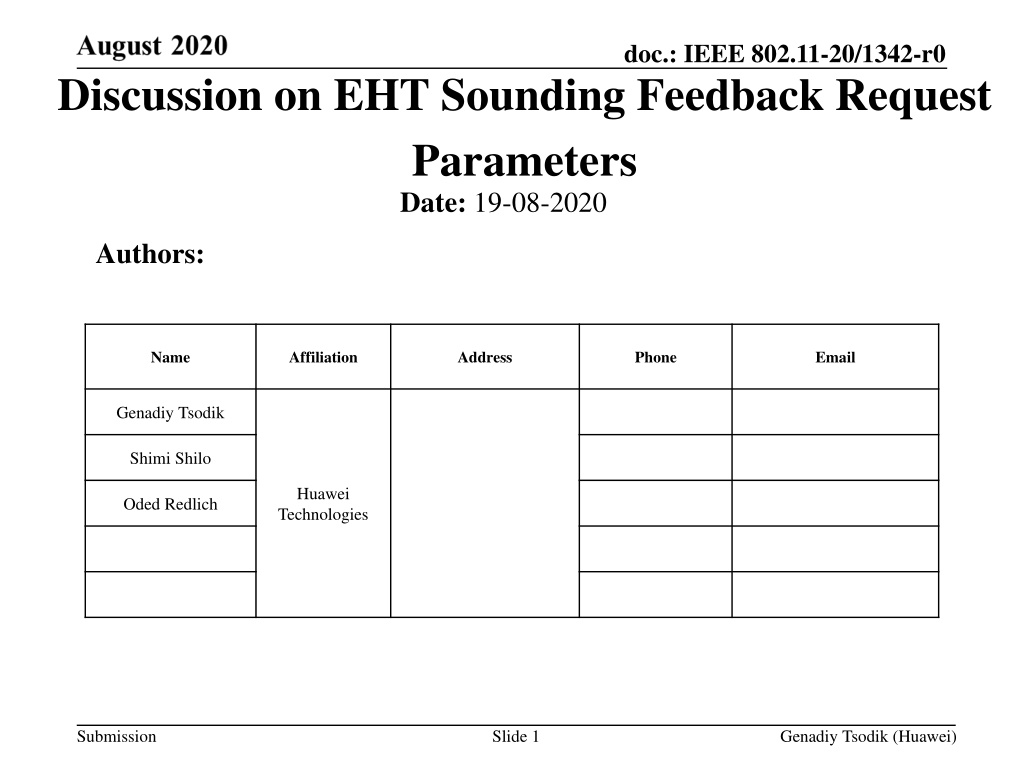
Enhancements in IEEE 802.11be Sounding Feedback Parameters
Explore the proposed modifications to feedback request parameters in IEEE 802.11be for enhanced throughput, including discussions on Ng values, codebook size, and subcarrier grouping. Simulation results and analyses provide insights into the impact on performance for different scenarios.
Download Presentation

Please find below an Image/Link to download the presentation.
The content on the website is provided AS IS for your information and personal use only. It may not be sold, licensed, or shared on other websites without obtaining consent from the author. Download presentation by click this link. If you encounter any issues during the download, it is possible that the publisher has removed the file from their server.
E N D
Presentation Transcript
doc.: IEEE 802.11-20/1342-r0 Discussion on EHT Sounding Feedback Request Parameters Date: 19-08-2020 Authors: Name Affiliation Address Phone Email Genadiy Tsodik Shimi Shilo Huawei Technologies Oded Redlich Submission Slide 1 Genadiy Tsodik (Huawei)
doc.: IEEE 802.11-20/1342-r0 Introduction 802.11be increases maximum throughput (increasing MCS, Nss and BW( which requires to update both feedback request and feedback response parameters For example, it was already accepted to extend the number of columns in feedback (Nc) up to 16 [1] In this contribution we review additional parameters and suggest the required extension or modification of existing fields Submission Slide 2 Genadiy Tsodik (Huawei)
doc.: IEEE 802.11-20/1342-r0 Parameters to review Three fields indicated in STA Info Subfield, as defined in 11ax, should be reviewed with respect to 802.11be requirements: Feedback Type and Ng Codebook Size Partial BW Info this field is not discussed in this contribution We examined different scenarios introduced by 802.11be with respect to Ng values and Codebook Size In the next slides we will present simulation results and our suggestions for Ng value and Codebook Size in 802.11be Submission Slide 3 Genadiy Tsodik (Huawei)
doc.: IEEE 802.11-20/1342-r0 Subcarrier Grouping - Ng 802.11ax introduced two possible values of subcarrier grouping: Ng=4 and Ng=16 Larger Ng values allow smaller feedback size but provide a less accurate precoder (and hence degrade performance) SU case In [2] a throughput analysis was presented, showing that for the SU case feedback reduction results in very small throughput gain Thus we see no motivation to change/extend Ng values for SU case MU case Involving multiple STAs in sounding procedure may lead to very large feedback size On the other hand, MU case requires a more accurate precoder Hence we simulate and analyze the MU case Submission Slide 4
doc.: IEEE 802.11-20/1342-r0 Simulation Parameters - Ng We compared the performance of both Ng (4 and 16) values in different scenarios, focusing on MU-MIMO Although cases with a small number of antennas (< 8) are not relevant for feedback size reduction (no change from 802.11ax), we still simulated them to get a better understanding of achievable performance Simulation parameters are: 4/8/16 Tx antennas 2/3/4 STAs with 1SS each (BF size per STA is 4x1, 8x1, 16x1) 6 STAs with 2SS each (total of 12SS) TGn-D NLOS Practical CHEST MCS 4/6/8/10 No Compression of feedback precoder Submission Slide 5
doc.: IEEE 802.11-20/1342-r0 Simulation Results - 4 Tx Antennas Submission Slide 6
doc.: IEEE 802.11-20/1342-r0 Simulation Results 8/16 Tx Antennas 8 Tx Ant, 4 STA 16 Tx Ant, 4 STA 8/16 Tx Ant, 6 STA, 6SS in Total 16 Tx Ant, 6 STA, 12SS in Total Submission Slide 7
doc.: IEEE 802.11-20/1342-r0 Ng Values - Conclusions The simulations reveal that: Ng = 16 provides reasonable performance degradation (and no error floor) in most simulated scenarios Larger number of antennas decreases the degradation caused by Ng=16, and for 16 Tx antennas the gap is very small (even for large MU-MIMO with 12SS total) Ng = 8 also yields some performance degradation in scenarios with a larger number of Tx antennas (cannot be considered as an alternative for Ng = 4) Based on these results we conclude the following: Ng = 16 may be used for many practical cases, such as smaller MU-MIMO groups, low and mid MCS values Larger MIMO schemes (more relevant for 11be) require Ng=4 to achieve desired performance Ng=16 may still be applied for MU-MIMO grouping algorithms where the accuracy of the precoder has little impact on the grouping algorithm (this allows to collect feedback from many STAs with lower feedback overhead) Thus following the above we suggest to reuse Ng values defined in 11ax For SU and MU Feedback types, Ng = 4 and Ng = 16 may be used Submission Slide 8
doc.: IEEE 802.11-20/1342-r0 Codebook Size 802.11ax supports two codebook size values per feedback type (2,4) and (4,6) bits for SU feedback type (5,7) and (7,9) bits for MU feedback type We examined different codebook size valuess (including un-supported sizes of (8, 10) and (9,11) bits) in typical and extreme scenarios introduced by 802.11be, including high MCS and large MU-MIMO cases Simulation parameters: Codebook size: (5,7), (7,9), (8,10) and (9,11) TGn-D NLOS 16Tx Ant 2/4/6/8 STAs Nss =2/4 Practical CHEST Extreme Cases: 4 STAs, Nss = 4 (16SS total) 6 STAs, Nss = 2 (12SS total) MCS11 Submission Slide 9
doc.: IEEE 802.11-20/1342-r0 Simulation Results Total Nss = 8 (50%) Total Nss = 12 (75%) Total Nss = 16 (Full Rank) Total Nss = 16 (Full Rank) Submission Slide 10
doc.: IEEE 802.11-20/1342-r0 Simulation Results Extreme Scenarios Total Nss = 12 (75%) MCS11 Total Nss = 16 (Full Rank) Submission Slide 11
doc.: IEEE 802.11-20/1342-r0 Codebook Size Conclusions From the simulation results we can see that for full rank MU-MIMO cases or high MCS with total Nss equal to 75% of Tx antennas, a codebook size of (7,9) bits results in non-negligible performance degradation A codebook size of (9,11) bits provided no performance degradation for all the scenarios whereas codebook size of (8,10) slightly degrades the performance in full rank MU-MIMO The performance gain of codebook size (9,11) yields higher goodput (taking into account the higher respective overhead) For example, in case of 8 STAs, the PER is reduced from 0.1 to 0.05, which means (assuming 30msec sounding period) that we save ~1.5msec of retransmission time by increasing the feedback size by ~400usec Thus, following those above, we suggest to support a codebook size of (11,9) bits for MU feedback type in addition to existing codebook sizes Submission Slide 12
doc.: IEEE 802.11-20/1342-r0 Proposed Changes in STA Info Subfield Following our suggestions we propose to extend Codebook Size field in STA Info Subfield by one bit B0 B1 Codebook Size Bits 2 The proposed change in Table 9-31a for indication of Feedback Type and Ng and Codebook Size will be as following (when B0 is 0 original settings are preserved ) Feedback Type and Ng B0 0 0 0 0 1 1 1 1 1 1 Codebook Size B0 0 0 0 0 0 0 0 0 1 1 Description B1 0 0 1 1 0 0 1 1 0 1 B1 0 1 0 1 0 1 0 1 1 1 SU, Ng = 4, quantization resolution ( , ( = {4,2} SU, Ng = 4, quantization resolution ( , ( = {6,4} SU, Ng = 16, quantization resolution ( , ( = {4,2} SU, Ng = 16, quantization resolution ( , ( = {6,4} MU, Ng = 4, quantization resolution ( , ( = {7,5} MU, Ng = 4, quantization resolution ( , ( = {9,7} CQI MU, Ng = 16, quantization resolution ( , ( = {9,7} MU, Ng = 4, quantization resolution ( , ( = {11,9} MU, Ng = 16, quantization resolution ( , ( = {11,9} Other Reserved Submission Slide 13 Genadiy Tsodik (Huawei)
doc.: IEEE 802.11-20/1342-r0 Proposed Changes in EHT MIMO Control Similar to the previous slide we suggest to extend Codebook Information field size by one bit Codebook Information B0 B1 Bits 2 The proposed change in Table 9-93a for indication of Codebook Information will be as following (when B0 is 0 original settings are preserved ) Codebook Information Indicates the size of codebook entries. If the Feedback Type subfield indicates SU: Set to 00 for 4 bits for and 2 bits for Set to 01 for 6 bits for and 4 bits for If the Feedback Type subfield indicates MU: Set to 00 for 7 bits for and 5 bits for Set to 01 for 9 bits for and 7 bits for Set to 10 for 11 bits for and 9 bits for Set to 11 Reserved If the Feedback Type subfield indicates CQI, then the Codebook Information subfield is reserved. NOTE The codebook size for MU Feedback with Ng = 16 is limited to ( , ( = {9, 7} or {11,9} Submission Slide 14 Genadiy Tsodik (Huawei)
doc.: IEEE 802.11-20/1342-r0 Summary We examined 802.11be supported schemes with respect to Ng values and Codebook Size Based on simulation results we proposed to preserve existing Ng values and codebook sizes and to add a new codebook size of (9,11) bits Following those suggestions, we proposed the relevant changes in STA Info Subfield and EHT MIMO Control Field We preserve the existing definitions and add new options by extending Codebook Size and Codebook Information fields by one bit Submission Slide 15 Genadiy Tsodik (Huawei)
doc.: IEEE 802.11-20/1342-r0 References [1] 11-20-0566-54-00be-compendium-of-straw-polls-and-potential- changes-to-the-specification-framework-document [2] 11-19-1495-02-00be-further-discussion-on-feedback-overhead- reduction Submission Slide 16 Genadiy Tsodik (Huawei)
doc.: IEEE 802.11-20/1342-r0 SP1 Do you agree to support Ng values defined in 802.11ax? - Ng = 4 and Ng = 16 for SU and MU feedback type Submission Slide 17 Genadiy Tsodik (Huawei)
doc.: IEEE 802.11-20/1342-r0 SP2 Do you agree to support to add a new codebook size of (9,11) bits for MU feedback type? - Note: the codebook sizes defined by 802.11ax will also be supported Submission Slide 18 Genadiy Tsodik (Huawei)
doc.: IEEE 802.11-20/1342-r0 SP3 Do you agree to extend Codebook Size field in STA Info Subfield by 1 bit and update the table 9-31a as defined in slide 13? B0 B1 Codebook Size Bits 2 Feedback Type and Ng B0 0 0 0 0 1 1 1 1 1 1 Codebook Size B0 0 0 0 0 0 0 0 0 1 1 Description B1 0 0 1 1 0 0 1 1 0 1 B1 0 1 0 1 0 1 0 1 1 1 SU, Ng = 4, quantization resolution ( , ( = {4,2} SU, Ng = 4, quantization resolution ( , ( = {6,4} SU, Ng = 16, quantization resolution ( , ( = {4,2} SU, Ng = 16, quantization resolution ( , ( = {6,4} MU, Ng = 4, quantization resolution ( , ( = {7,5} MU, Ng = 4, quantization resolution ( , ( = {9,7} CQI MU, Ng = 16, quantization resolution ( , ( = {9,7} MU, Ng = 4, quantization resolution ( , ( = {11,9} MU, Ng = 16, quantization resolution ( , ( = {11,9} Other Reserved Submission Slide 19 Genadiy Tsodik (Huawei)
doc.: IEEE 802.11-20/1342-r0 SP4 Do you agree to extend Codebook Information field in EHT MIMO Control Field by 1 bit and update the table 9-93a as defined in slide 14? B0 B1 Codebook Information Bits 2 Codebook Information Indicates the size of codebook entries. If the Feedback Type subfield indicates SU: Set to 00 for 4 bits for and 2 bits for Set to 01 for 6 bits for and 4 bits for If the Feedback Type subfield indicates MU: Set to 00 for 7 bits for and 5 bits for Set to 01 for 9 bits for and 7 bits for Set to 10 for 11 bits for and 9 bits for Set to 11 Reserved If the Feedback Type subfield indicates CQI, then the Codebook Information subfield is reserved. NOTE The codebook size for MU Feedback with Ng = 16 is limited to ( , ( = {9, 7} or {11,9} Submission Slide 20 Genadiy Tsodik (Huawei)

